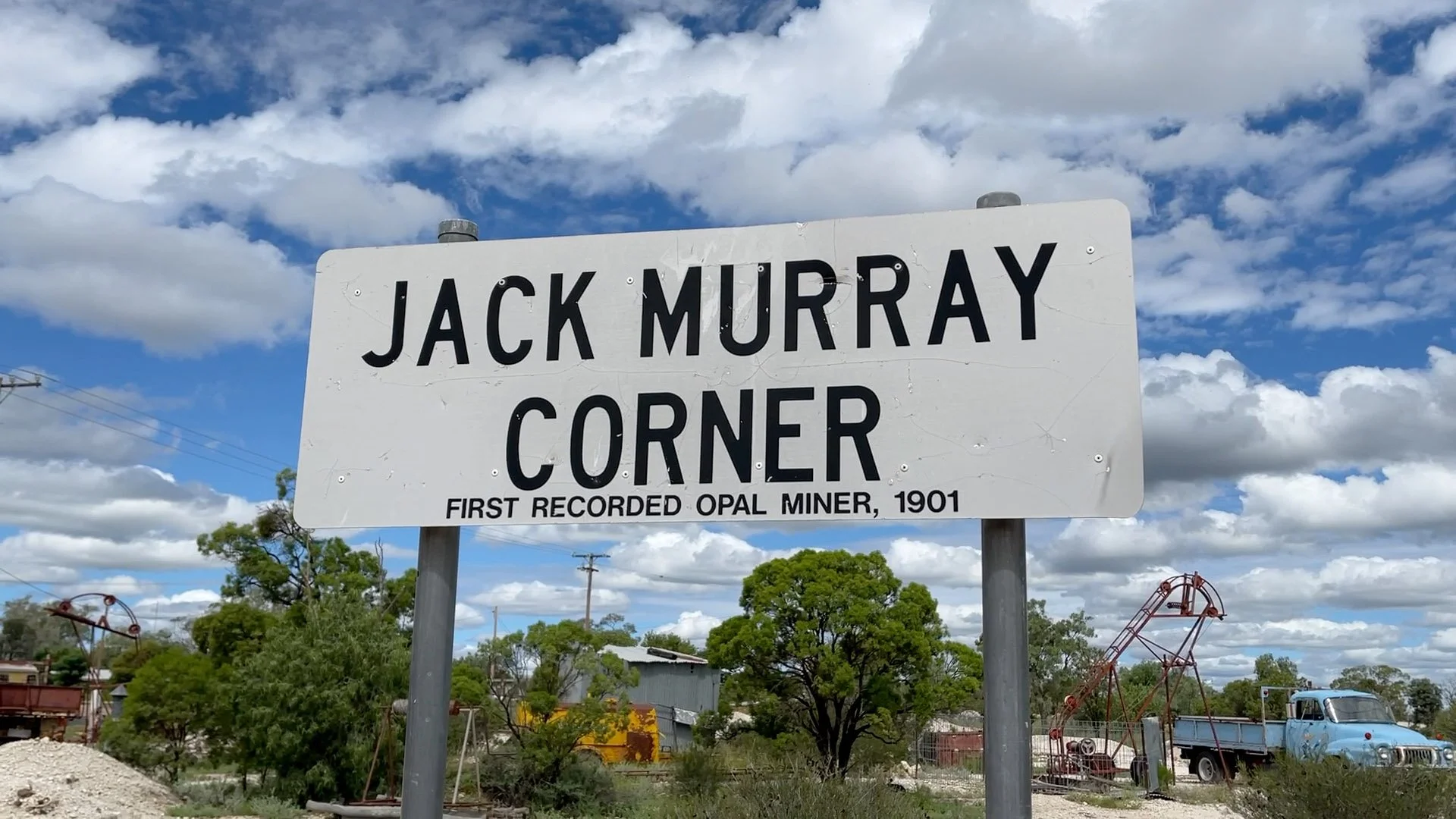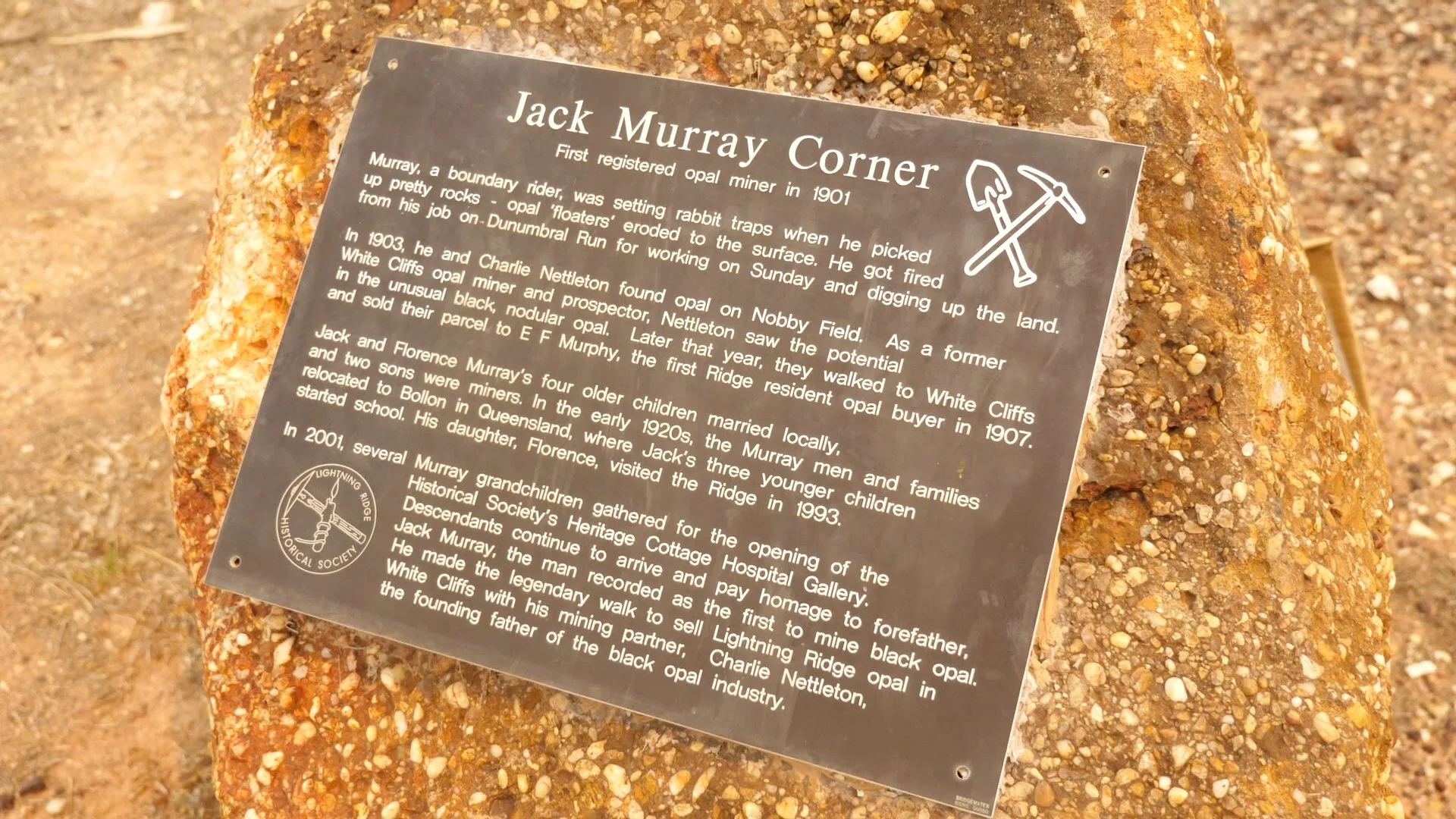John “Jack” Murray
Jack Murray, 1917. Lightning Ridge Historical Society.
Jack Murray was the first opal miner at Lightning Ridge, as referenced in Frank Leechman’s The Opal Book, 1961.
John “Jack” Murray was born in 1870 at Gunnedah. His parents, James Murray and Rosanna Ewing emigrated from Wigtownshire, Scotland.
Jack married Florence Heness, daughter of Walter "Watty" Heness in 1898. Florence was 15 years old at the time, her mother’s permission was given for the marriage. The Murray family became quite large over time, with many children. The eldest, Victor Murray was born in 1898 with Anna May born in 1903.
In 1901, Jack was a boundary rider on Dunumbral Station, on Bundinbarrina Run. He was out setting rabbit traps when he picked up ‘floaters’ of opal, pieces brought to the surface by erosion. He was fired from his job for digging up the land rather than looking after it.
“Jack Murray, he said, had been employed by Dungalear station and had been living with his wife and family where Underwood’s now is. “He started,” Mick said, “working on Sundays putting a hole down, and so lost his job.”
In early 1903, Charlie Nettleton was working on the Six Mile ridge, under the employ of the syndicate established by Joe Beckett of Weetalibah. After sinking a shaft and finding no opal, the syndicate dissolved and Nettleton moved across to join Murray on the Nobby opal field.
“After leaving station job, [Murray] worked with Charlie Nettleton on Sims’ Hill and Nobby fields. They got good opal.”
At the same time Jack was finding surface opal as he set rabbit traps, his wife Florence and young son Victor found surface opal after rain. Victor was seen playing marbles with the precious stones, unaware of what they were.
“Just after the Bruces landed at the Ridge ( 1908) a bloke by the name of Jack Murray [...] told my grandfather that he sank a shaft on the southern slope of Nobby during the latter end of 1902. The reason for his sinking the shaft was that the Murray kids had picked up surface Opal.”
“Nettleton went on to Simm’s [sic] Hill, where he camped at the boundary hut, which was in charge of Jack Murray. Here he saw Murray’s youngsters playing marbles and “jacks” with some beautiful stones. A piece that he took from the hand of one of the kiddies was a perfect ball of fire, without a sign of potch. Murray told him he had thrown away a galvanised bucket full of similar stones from time to time, and those the children were playing with were some they had picked up in the watercourse that fed the tank.”
On the Nobby field, Nettleton and Murray found opal, which Murray attempted to sell by sending it to Sydney in a similar fashion to Robert Moore some 30 years prior. Unfortunately, like Moore, he had no success. Following Nettleton's connections, the parcel of opal was walked along the rivers to Wilcannia and up to the opal fields at at White Cliffs, some 400+ miles. Arriving at White Cliffs amid November heat, the first parcel of Lightning Ridge black opal was sold to opal buyer Ted Murphy, working as agent for T.C. Wollaston.
After the sale of the first parcel of opal at White Cliffs, Murray continued business with Ted Murphy, selling many future parcels to Murphy who in 1909-1910 lived right next door to Murray in the main street.
Murray saved the proceeds from his opal sales and by 1915 invested in a horse team and wagon. He worked locally carrying goods to and from the railhead at Walgett. In 1919 he was recorded in a wagon accident while transporting goods, he was taken to hospital in a serious condition.
Murray and family moved from Lightning Ridge to Bollon, Queensland in the late 1920s, where he ran a courier and ringbarking business, also offering fencing and scrub-cutting services.
“Later on [Murray] bought horse team and used it carrying supplies from Walgett, and wool back to railhead. Went back to St. George finally and set up as a ring-barking contractor.”
Photographs of Jack Murray
There has been some dispute over the identity of the person in the photograph shown above. Some sources identify the person as Jack Murray, others as Victor Murray, Jack’s eldest son. The photograph was taken in 1917, when Jack Murray would have been 47 years of age. Victor would have been nineteen in 1917. While it is impossible to be certain, it seems reasonable the man in the photograph is 47-year-old Jack, rather than teenage Victor. Research into the collection of photographs held by the Lightning Ridge Historical Society has produced two more images which likely show the same person, and if so the years the photographs were taken help to confirm the man with the horse is indeed Jack Murray. One photograph shows a man who looks identical to Murray, wearing a similar style of hat, standing outside Watty Vause’s general store and post office. The other photograph shows Lana Dawe and Jack Murray’s wife Florence in the foreground holding a child (Ailsa Darby), with a man very similar in appearance to Jack walking past in the background. Note the identical hat in the 1917 and 1923 photographs.
Three photographs of—very likely—Jack Murray. Left, 1910, outside Watty Vause’s general store. Middle, 1917, on the day Murray received his new horse. Right, 1923, in the background of a photograph (left of frame) of Lana Dawe and Florence Murray.
Jack Murray's contribution to opal history is commemorated at Jack Murray Corner in Morilla Street, which visitors see on the way into town.
Jack Murray died on 27 December 1952 and is buried at Bollon Cemetery. It was raining heavily the week that Jack passed away, so much that it was impossible to bring a minister to town, so the service was conducted by a respected Bollon local.
Signature of Jack Murray, sourced from the 1929 petition for a public park at Lightning Ridge.
Article: Research by Leisa Carney and Russell Gawthorpe, edited by Russell Gawthorpe. LRHS research compiled by Len Cram and Barbara Moritz. Sources: ‘Peculiar Mishap to Carrier’, Daily Observer, 11 February 1919, p. 1; J. Drayton, 'Real Opals in the Ring', Smith's Weekly, 26 May 1923, p. 29; ‘Court of the Flame Queen - Romance of Opal - Old Timer’s Story - Some Famous Gems’, Daily Standard, 14 June 1935, p. 4; The Opal Book, Frank Leechman, 1961, pp. 68-72, 221, 223; The Lightning Ridge Book, Stuart Lloyd, 1967, p. 160-163; Lightning Ridge - The Home of the Black Opal: Unique to the World, Gan Bruce, 1983, p. 10; The Bolion (or: Bollon on the Wallam in the 1900s), E. C. “Bunny” Powne, 2002, pp. 112-115; A Journey With Colour: A History of Lightning Ridge Opal 1873-2003, Len Cram, 2003, pp. 12-13, 15-16, 19, 355.





